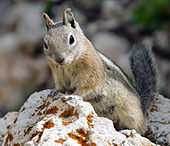Caucasian squirrel
| Persian Squirrel | |
|---|---|
 | |
| Conservation status | |
| Scientific classification | |
| Kingdom: | Animalia |
| Phylum: | Chordata |
| Class: | Mammalia |
| Order: | Rodentia |
| Family: | Sciuridae |
| Genus: | Sciurus |
| Subgenus: | Tenes Thomas, 1909 |
| Species: | S. anomalus |
| Binomial name | |
| Sciurus anomalus Gmelin, 1778 | |
| Subspecies[2] | |
| |
The Caucasian squirrel (or Persian squirrel) (Sciurus anomalus) is a tree squirrel in the genus Sciurus found in Armenia, Azerbaijan, Georgia, Greece (only in the island of Lesbos), Iran, Iraq, Israel, Jordan, Lebanon, Syria, and Turkey. Its natural habitat is temperate broadleaf and mixed forests.[1]
Description
The species was identified by Johann Friedrich Gmelin in 1778 and named Sciurus anomalus,[1] although it has also been credited to Johann Anton Güldenstädt.[3] The common English name for the species is the Caucasian squirrel, also known as Persian squirrel.[1]
Samuel Griswold Goodrich described the Caucasian squirrel in 1885 as "Its color is grayish-brown above, and yellowish-brown below".[4] The Caucasian squirrel has a body length of between 20–30 centimetres (7.9–11.8 in) and can weigh between 200–1,000 grams (0.44–2.20 lb).[5]
Habitat
The species mainly lives in forested areas featuring coniferous and/or deciduous trees in Turkey and throughout the countries in the Middle East and Eurasian regions but the range also stretches as far south east as Iran and Iraq. In the Mediterranean, they are native to Gökçeada and Lesbos.[1] It is one of two species of the genus Sciurus to be found on Mediterranean islands.[3] The Caucasian squirrel lives in areas as high as 2,000 metres (6,600 ft).[1] They live in trees, where they make their dens. Their diet includes nuts, seeds, tree shoots and buds.[5]
A survey in 2008 found that the species remained abundant within Turkey, however declines are noted in population within the Levant region. The guides for a survey in 1993 in Israel stated that they considered the species to be nearly extinct within the area studied. Whilst the Caucasian squirrel is threatened by poaching and deforestation, the declines recorded are not sufficient to qualify them as anything other than "Least Concern" by the International Union for Conservation of Nature.[1] Hunting of the species is banned by the Central Hunting Commission, and the Caucasian squirrel is protected by the Bern Convention and the EU Habitats Directive.[5]
References
- ↑ 1.0 1.1 1.2 1.3 1.4 1.5 1.6 Yigit, N., Kryštufek, B., Sozen, M., Bukhnikashvili, A. & Shenbrot, G. (2008). Sciurus anomalus. In: IUCN 2008. IUCN Red List of Threatened Species. Retrieved 6 January 2009.
- ↑ Thorington, R.W., Jr.; Hoffmann, R.S. (2005). "Family Sciuridae". In Wilson, D.E.; Reeder, D.M. Mammal Species of the World: a taxonomic and geographic reference (3rd ed.). The Johns Hopkins University Press. pp. 754–818. ISBN 0-8018-8221-4. OCLC 26158608.
- ↑ 3.0 3.1 Masseti, Marco (2012). Atlas of Terrestrial Mammals of the Ionian and Aegean Islands. Boston: De Gruyter. pp. 60–61. ISBN 978-3110254570.
- ↑ Goodrich, Samuel Griswald (1885). Johnson's Natural History 1. New York: A.J. Johnson & Co. p. 372.
- ↑ 5.0 5.1 5.2 "Appendix B1 - Mammal Species Dossier" (PDF). British Petrolleum. October 2002. Retrieved 14 July 2013.
External links
| Wikimedia Commons has media related to Sciurus anomalus. |



